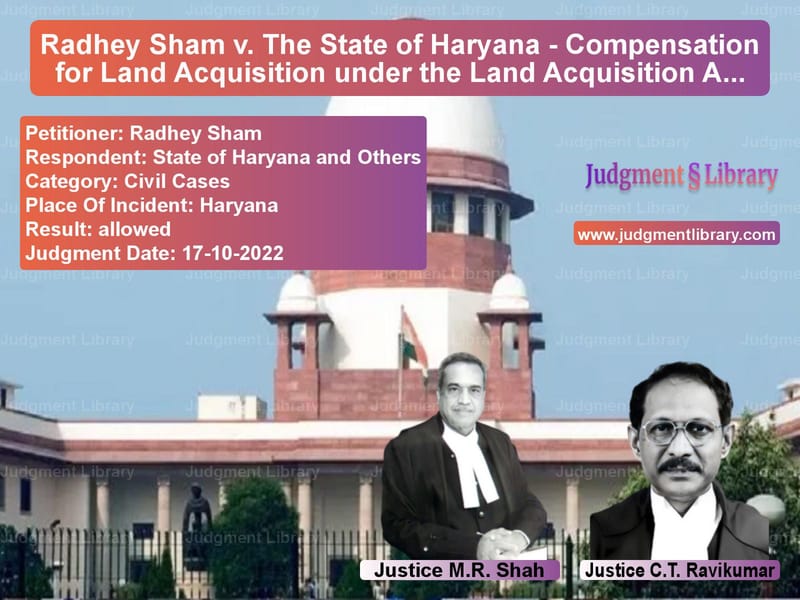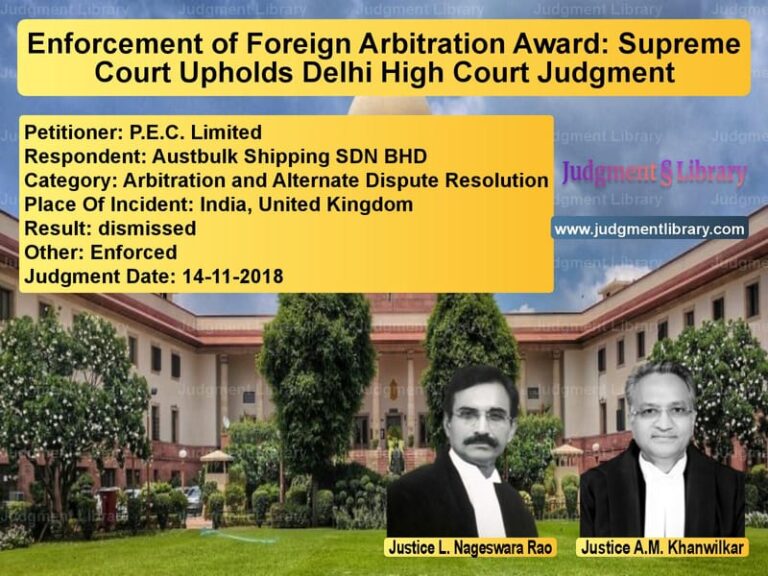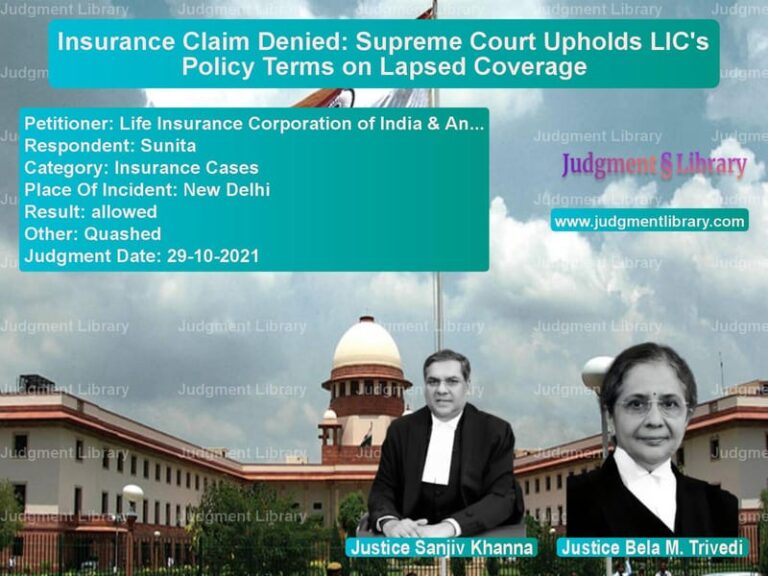Radhey Sham v. The State of Haryana – Compensation for Land Acquisition under the Land Acquisition Act
The case concerns an appeal filed by Radhey Sham and other landowners against the State of Haryana regarding the compensation for land acquired under the Land Acquisition Act, 1894. The land in question, situated at villages Hansi and Dhana in the district of Hisar, Haryana, was acquired for residential and commercial purposes. The original compensation assessed by the Land Acquisition Collector was Rs. 12,00,000 per acre for land abutting the main road and Rs. 8,00,000 per acre for the remaining land. The landowners had filed a reference before the Reference Court, which enhanced the compensation to Rs. 1,000 per square yard (approximately Rs. 48,20,000 per acre).
The State, unsatisfied with the compensation determined by the Reference Court, filed an appeal before the High Court, which quashed the Reference Court’s judgment and reduced the compensation. The landowners have now filed an appeal before the Supreme Court, challenging the High Court’s decision and seeking a higher compensation.
Petitioner and Respondent Arguments
Petitioner’s Arguments:
- The appellants, represented by Senior Counsel, argued that the State had accepted the compensation awarded by the Reference Court in 2014 at Rs. 1,000 per square yard and did not challenge it in time. The appellants claimed that the State had implicitly acknowledged the correctness of the Reference Court’s decision by not filing any appeal against it. Therefore, the appellants contended that they were entitled to the compensation of Rs. 1,000 per square yard, which had been accepted by the State.
- The appellants also emphasized that the earlier judgment and order of the Reference Court were based on substantial evidence, including sale deeds, which showed that the market value of the acquired land was at least Rs. 1,000 per square yard. They further argued that the compensation awarded by the High Court was far below the market value, leading to significant financial losses for the landowners.
Respondent’s Arguments:
- The respondent, representing the State of Haryana, argued that the compensation awarded by the Reference Court was excessive and that the State was within its rights to challenge the judgment. The State contended that the compensation should reflect the prevailing market conditions and that the landowners had failed to produce convincing evidence of the land’s actual market value. The State also highlighted that the compensation calculated by the Land Acquisition Collector at Rs. 12,00,000 per acre for land near the main road and Rs. 8,00,000 per acre for the remaining land was fair and reasonable.
- Furthermore, the respondent emphasized that the landowners’ reliance on sale deeds prior to the Section 4 notification (issued in 2005) was misplaced, as the sale deeds were from 1992-1994 and involved smaller parcels of land, which were not comparable to the acquired land in terms of value.
Key Issues and Supreme Court’s Ruling
The Supreme Court addressed the following key issues in this case:
1. Compensation Awarded by the Reference Court
The first issue that the Supreme Court examined was whether the compensation awarded by the Reference Court at Rs. 1,000 per square yard was appropriate. The Court noted that the Reference Court’s decision was based on certain sale deeds and the overall market conditions at the time of acquisition. However, the Court also acknowledged that the State had not challenged the Reference Court’s judgment when it was first passed. The Court observed that the failure of the State to appeal the Reference Court’s judgment in time implied that the compensation amount of Rs. 1,000 per square yard had been accepted by the State and, therefore, the landowners were entitled to that amount.
2. The Market Value of the Acquired Land
The Court then considered the market value of the acquired land and whether it justified the compensation awarded by the High Court, which reduced the compensation. The landowners had relied on sale deeds that showed a higher price for similar land in the vicinity of the acquired land. However, the Court noted that the sale deeds relied upon by the landowners were from an earlier period, prior to the Section 4 notification, and were for smaller parcels of land. These sales, the Court concluded, were not entirely comparable to the large tracts of land that had been acquired for development purposes.
Despite this, the Court observed that the landowners had provided substantial evidence to show that the compensation awarded by the High Court was not in line with the actual market value of the land. The Court noted that the compensation at Rs. 1,000 per square yard was reasonable, considering the evidence and the accepted market conditions at the time of the acquisition.
3. Fairness of the High Court’s Compensation
The Supreme Court also examined the fairness of the compensation awarded by the High Court. The Court concluded that the High Court had erred in reducing the compensation below the amount determined by the Reference Court, which had already been accepted by the State. The Court emphasized that the landowners were entitled to the compensation that reflected the actual market value of the land, as determined by the Reference Court and not the reduced amount awarded by the High Court.
Conclusion
The Supreme Court allowed the appeal filed by the landowners and set aside the judgment and order of the High Court, restoring the award of compensation at Rs. 1,000 per square yard as determined by the Reference Court. The Court ruled that the State had implicitly accepted the earlier compensation award by not challenging it, and the landowners were therefore entitled to the compensation at the rate of Rs. 1,000 per square yard. The Court also emphasized that the compensation should reflect the true market value of the land and should not be reduced arbitrarily.
This judgment serves as a reminder that the legal process must be followed diligently, and that compensation should be fair and reflective of market conditions. It also reinforces the idea that parties to a land acquisition case should act promptly in challenging decisions if they believe the compensation is inadequate.
Impact and Implications
The decision will have a significant impact on land acquisition cases in India, especially in terms of determining fair compensation for landowners. The ruling sets a precedent for the determination of compensation in such cases, emphasizing that compensation should be based on the market value of the land at the time of acquisition and should not be reduced arbitrarily. It also underscores the importance of timely appeals and the acceptance of compensation when no appeal is filed.
Petitioner Name: Radhey Sham.Respondent Name: State of Haryana and Others.Judgment By: Justice M.R. Shah, Justice C.T. Ravikumar.Place Of Incident: Haryana.Judgment Date: 17-10-2022.
Don’t miss out on the full details! Download the complete judgment in PDF format below and gain valuable insights instantly!
Download Judgment: radhey-sham-vs-state-of-haryana-and-supreme-court-of-india-judgment-dated-17-10-2022.pdf
Directly Download Judgment: Directly download this Judgment
See all petitions in Contract Disputes
See all petitions in Property Disputes
See all petitions in Damages and Compensation
See all petitions in Environmental Cases
See all petitions in Judgment by Mukeshkumar Rasikbhai Shah
See all petitions in Judgment by C.T. Ravikumar
See all petitions in allowed
See all petitions in supreme court of India judgments October 2022
See all petitions in 2022 judgments
See all posts in Civil Cases Category
See all allowed petitions in Civil Cases Category
See all Dismissed petitions in Civil Cases Category
See all partially allowed petitions in Civil Cases Category







